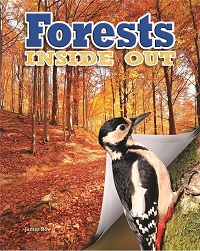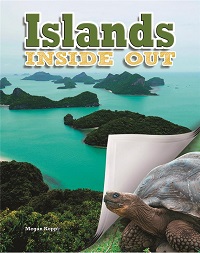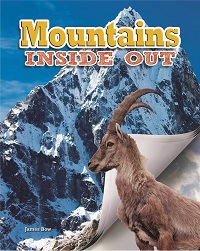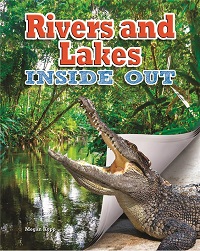| ________________
CM . . .
. Volume XXII Number 9. . . .October 30, 2015
excerpt:
The 12-volume “Ecosystems Inside Out” series examines the Earth’s biomes and provides information about the interdependence between the plants and animals that live there. Each of the titles begins in a similar fashion with an introduction to ecosystems and such terms as biotic, abiotic and biome. Their layouts are identical as well, with a double-page spread devoted to each of the 13 chapters. Following a two or three paragraph explanation of the specific topic, the chapter includes an “Eco Up Close” section consisting of a close-up photo of a plant or animal that inhabits that particular area of the world and a text box explaining the specific adaptation of that organism. One example is the porcupine, an herbivore commonly found all across North America. Along with its protective quills, its ability to live in many different environments and to eat almost any plant makes it easy for the porcupine to live in many different ecosystems. “Eco Focus” text boxes present real-life scenarios, usually related to the environment and the preservation of a species or biome. These text boxes invite readers to think critically about a specific issue. There is also an activity or experiment to try at the back of each book. Throughout the series, the underlying theme is the delicate balance in an ecosystem where one seemingly small change can adversely affect- or even destroy- an entire ecosystem, The books give an example of a food chain specific to the featured ecosystem, provide information about the various flora and fauna present, and offer suggestions for protecting the environment. Though the sentences are fairly short and simple, suitable for the target audience, some of the vocabulary is rather sophisticated: terms such as symbiosis, parasitism, mutualism, commensalism, predation, opportunistic feeders, apex predators and symbiotic relationships are used frequently. Illustrations consist of maps, diagrams and colour photographs. A table of contents, a glossary and an index are included, along with a list of books and web sites for further study. Forests have been called the “lungs of our planet”. In Forests Inside Out, readers will learn about the various types of forests and how they are affected by their location in the world, their elevation and the climate. Some, like the tropical rain forests, are evergreen while tropical dry forests and temperate broadleaf forests are mainly deciduous, the latter type boasting gorgeous fall colours as the weather gets colder. Some of the other forests featured in this title are the taiga, which is the most northerly type and consists mostly of coniferous trees; montane forests, which grow on mountain sides; swamps and mangrove forests; and kelp forests, found in the ocean close to the Pacific coast. An experiment at the back of the book will demonstrate how a bromeliad plant catches and holds water. Islands can be formed in various ways, ranging from coral reefs to volcanic eruptions and earthquake activity. A few of the islands featured in Islands Inside Out are the Galápagos Islands, the Florida Keys, and islands of the Caribbean and Hawaii. Barrier islands, common along the coasts of the United States, are narrow strips separated from the mainland by estuaries, bays or lagoons, effectively blocking winds and ocean waves. Other areas include the Aleutian Archipelago, home to millions of birds, Indonesia, which boasts extremely rare endemic species, Madagascar, which has over 12,000 species of unique plants, including eight species of the baobab tree, Japan, and Greenland, the world’s largest island which is covered by an icecap several thousand feet thick. Indonesia’s endemic species are particularly interesting, some examples of which are the world’s largest flower which can grow almost a meter wide, and hundreds of species of fig trees, each one having a different species of wasp responsible for its pollination. The experiment at the back of the book shows the effects of salt water on plant growth. The types of mountain ranges described in Mountains Inside Out are presented in order of elevation, from lowest to highest, beginning with foothills where the process of weathering forms silt that creates fertile soil for plant growth. Mostly coniferous montane forests, where the Chinook salmon is the keystone species, are next, followed by cloud forests which are often covered by clouds or fog. Cloud forests support a lot of mosses and ferns. Alpine grasslands have no trees, only grasses and shrubs, and though the animals found there are similar to those found at lower elevations, the animals tend to be much smaller because there is less food to eat and fewer places to hide from predators. Plants and animals need to be tougher on the Alpine tundra where the growing season is short and most of the moisture comes from snow that creates mountain streams. Plateaus and montane steppes can be found at high elevations where the crust of the Earth has pushed up, creating large areas of land suitable for herds, such as yaks, to graze. Finally, there is what is known as the “Death Zone”, about 8,000 meters above sea level. This area has only about one-third the air pressure of land at sea level, and the presence of high winds, extremely low temperatures and more harmful ultraviolet rays make it a very hostile environment. This title also devotes a spread to seamounts, underwater mountains usually formed by extinct volcanoes that rise over 300 meters above the sea floor. The experiment at the back of the book provides instructions on how to build a wind tunnel to find out how mountains affect air and water currents. Finally, Rivers and Lakes Inside Out focuses on some of the world’s most important inland bodies of water. From South America’s Amazon River to Africa’s Nile, the longest river in the world, and from Asia’s Yangtze, whose forests in the upper area are the perfect habitat for the giant panda, to North America’s Colorado River system, this title not only stresses the importance of these rivers, but it also illuminates the concerns that scientists have about deforestation, overhunting, overfishing and the destruction of habitats in the areas surrounding the rivers. The lakes featured in this book include the Great Lakes, the largest freshwater system on Earth; the Great Salt Lake, the remains of a huge lake dating back to the ice age and too salty to support most aquatic species; Lake Mead, a manmade reservoir; Crater Lake, a caldera that is the deepest lake in the United States; and Lake Baikal in Siberia. Lake Baikal is the deepest lake in the world, and most of its species are endemic. One of them, the Golomyanka, is a rare fish that does not lay eggs. Instead, it gives birth to live young. Also mentioned in this title are the various issues of concern such as dam building, cottage development, pollution from industrial waste, runoff from farming, and sewage, and the problems inherent in the introduction of non-native species to specific habitats. Lastly, the book explains the critical importance of a healthy watershed and provides instructions for making a simple watershed model to see how water flows. Worthy of purchase, the “Ecosystems Inside Out” series will be useful in a classroom or school library. Recommended.
Gail Hamilton is a former teacher-librarian in Winnipeg, MB.
To comment on this title or this review, send mail to cm@umanitoba.ca.
Copyright © the Manitoba Library Association. Reproduction for personal use is permitted only if this copyright notice is maintained. Any
other reproduction is prohibited without permission.
CM Home |
Next Review |
(Table of Contents for This Issue - October 30, 2015.)
| Back Issues | Search | CM Archive
| Profiles Archive |



